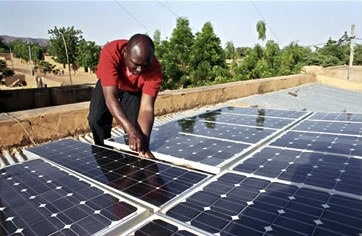

Africa, with its 54 countries, has a total population the size of India, and an area that is well over nine times India’s. However, the continent has lagged on solar installations, despite severe energy shortages, with just around 6.6 gigawatts (GW), the continent is only home to around one percent of the PV capacity installed worldwide as of the end of 2019. Ironically, this is happening even as Africa has some of the highest irradiance zones on Earth.
Not just that, the region has some of lowest per capita energy consumption levels, driven by low energy access as well as poor quality of generation and grids. Thus, the Intersolar Solarize Africa Market Report 2020 takes a closer look and presents an analysis of the market in select African countries, for the first time including Senegal, Mali, Uganda, Madagascar, Kenya and Tunisia. The report investigates the various phases of the photovoltaics markets for 16 African countries as well as their individual regulatory conditions and potential for photovoltaic installations. Thus, the country attractiveness rankings offer both investors as well as policy makers some pointers on possible steps to take or emulate, in this case.
It’s not like not much is happening. Many countries have projects in the pipeline, some on a significant scale, and the underlying political conditions are improving all the time. For instance, Algeria is planning to install photovoltaic systems with a combined capacity of 4 GW by 2024, while the end of 2019 marked the completion of Egypt’s Benban Solar Park. With a total installed capacity of 1.5 GW and six million photovoltaic panels, Benban is the largest solar park in Africa and amongst the biggest in the world. And Egypt is planning to install another 3.5 GW of solar energy capacity by 2027. Kenya had plans to set up commercial PV installations with a total capacity of 500 megawatts (MW) as of 2019 and contracts were recently finalized to build a solar park of the same size in Mali. “Africa is on the threshold of a major transformation, which can best be described as a kind of wave that just keeps swelling. We are excited to see what will come next,” says David Wedepohl, CEO of the German Solar Association (BSW-Solar)
The report goes ‘scenario mapping’ too, with four possible scenarios outlined for solar. The “policy-driven” and “business as usual” scenarios are based on the various countries’ current expansion goals and assume cumulative photovoltaic capacity of approximately 70 GW by 2030. More probable is the “solarize Africa accelerated” scenario, which presumes that photovoltaics in Africa will develop broadly in the same way as in other parts of the world, giving 170 GW of installed capacity by 2030. The central assumption of the fourth scenario – the “solarize Africa paradigm shift,” which builds on the current atmosphere on the continent – is that the African markets are in some respects skipping over the fossil fuel age altogether. It combines the installed PV capacity with the targets laid out in the Paris Agreement. With a cumulative capacity of 600 GW by 2030, this scenario envisions Africa as a very important region on the future global PV market.
An interesting aspect that has been taken up is the continent’s potential for mini-grids as well delivering clean water using solar. Readers will be aware that many large African countries are already key markets for distributed solar products. Africa is potentially half the global market for mini-grids, for instance, says the report. This is possibly due to the limited reach of national grids too.
The potential for combining solar energy and water seeks to consider an important issue. A billion people in Africa do not have access to clean drinking water. Water desalination and purification plants as well as pump units powered by photovoltaic systems are needed as one of the building blocks of a safe and environmentally friendly water supply. The lack of clean water is thus also a driving factor for photovoltaics deployment worldwide – while photovoltaics forms part of the solution to the many challenges present in this area. One example of the rise in innovative solutions for water and photovoltaics in Africa can be seen in Kenya. A solar-powered microgrid desalination plant on the coast supplies 25,000 people with fresh water every day. Floating photovoltaic installations are also already in use in parts of Africa.
With most of the largest African countries already part of the International Solar Alliance (ISA), which is seeking precisely the sort of solutions the report envisages, one would like to hope that India, along with European firms will have a role to play in the solarisation plans of Africa soon.
The first unit of the Compressed Biogas Plant built by Reliance at the Peddapuram Industrial…
As Karnataka gains momentum in the direction of ‘waste to energy,’ the Mysuru City Corporation…
DCM Shriram Limited has announced that it has successfully commissioned a new Compressed Biogas (CBG)…
TKIL Industries has partnered with global biogas conglomerate KIS Group to advance the production of…
1. What is Awite and what does it have to offer to the Indian biogas…
The Indian Federation of Green Energy (IFGE) and the Embassy of Nepal have jointly organized…